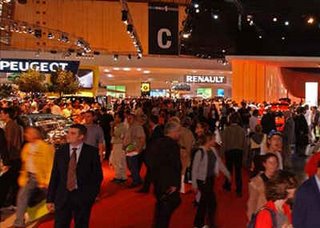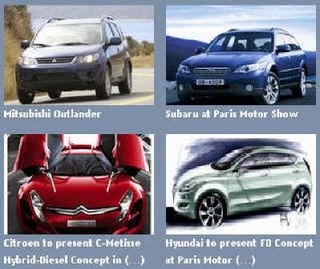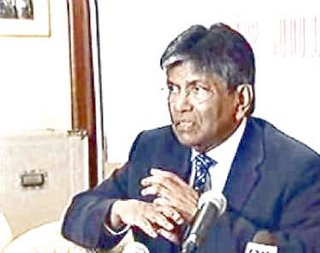US4 Million FERRARI CAR - PARIS MOTOR SHOW 2006; Owner: James Glickenhaus, Wall Street Fund Manager; More than 60 Concept and Production Cars Display



The 
ABOVE:The car was created for collector James Glickenhaus, and is valued at around $4 million. It was inspired by the P4 racer of the 1960s. Essentially, the P4/5 is a rebodied Ferrari Enzo, with a Pininfarina-designed exterior. BELOW: James inside his car with the "thumbs up" sign at the Paris Show
Today, the Auto Show serves a twofold purpose. It is not just a huge showcase where the general public can admire models built throughout the world, it is also a favorite meeting place for professionals from all branches of the automobile industry. 

Though many other auto shows have come into existence since 1898, the first to have been staged remains the premier event both in 

Before 1914,
![]() The Paris Motor Show 2006 opened Thursday in
The Paris Motor Show 2006 opened Thursday in
ABOVE: Hyundai Motor’s concept car Arnejs at the
The reason so many Korean carmakers take part in the Paris Motor Show is that they urgently want to boost their exports to
ABOVE: Kia Motors’ new Cee'd compact car at the
Kia Motors unveiled its Cee’d line, developed with an eye on European customers by its chief design officer Peter Schreyer, who should know since he used to work for Volkswagen. The Cee’d will be produced at Kia’s Zilina factory in
Hyundai Motor introduced a concept car named Arnejs at the show. The hatchback model equipped with a 2,000 cc diesel engine was developed by Hyundai’s design research institute in
ABOVE: The Audi R8/provided by Audi
The Audi R8 made an impressive debut at the show. The high-performance sports car with 420 horsepower and a maximum speed of 301 km/h comes with a bodyline design that, the company believes, conjures the image of a running leopard. Mercedes-Benz introduced high-performance models: the CL 63 AMG, a 525-horsepower car, and the SLR McLaren 722 Edition super sports car. Peugeot unveiled the 908 RC concept car equipped with a 5,500 cc engine which will compete in the 24 Hours of
But European carmakers are also doing battle with the Japanese for the future of the environmentally friendly car market. Toyota, the leader in hybrid car development, introduced the Lexus LS600h, the world’s first V8 hybrid sedan. With 430 horsepower, the LS600h is also
Other Concept Cars

 To see a BIGGER View of these models, GoTo
To see a BIGGER View of these models, GoTo


The follwing Models are from here




Global automakers unveil strategies at
The Paris Motor Show is now the stage where
BY LAURENCE FROST AND MATT MOORE; Associated Press
The 2006 show finds manufacturers on both sides of the Atlantic cutting jobs, closing higher-cost plants and scrambling to revamp aging model ranges as they lag behind the profitability and growth of competitors like
On their home turf, French automakers gave new momentum to an attempted push by
Renault presented a prototype SUV called Koleos and a sporty concept car, Nepta. Chief Executive Carlos Ghosn said the cabriolet's design offered a hint of the eight high-end models the company plans to launch by 2010, starting with a new Laguna sedan.
Another Renault prototype revealed the smarter features of the new Twingo, to be launched next year. The once-popular supermini has steadily lost ground to newer rivals like
A new, sporty 1.8-liter Yaris was among
Citroen excited the crowds with its C-Metisse, a sleek coupe prototype powered by a hybrid diesel-electric engine of the kind that will equip vehicles available from PSA Peugeot-Citroen's stable around the end of the decade.
DaimlerChrysler, a mainstay in the upscale market through its Mercedes brand, showed off new high-performance CL63 and S63 AMG models along with a silver, sleek SLR McLaren 722.
Mercedes is recovering from a weak patch, when business was undermined by quality and reliability concerns, and global unit sales for January through August were 11 percent higher than in the year-earlier period.
''We have worked hard and achieved a great deal -- and now we are reaping the benefits,'' CEO Dieter Zetsche said.
DaimlerChrysler's micro carmaker, Smart, showed off a revamped version of its peppy two-seater that is ubiquitous in European cities but will not be available in the
HYBRIDS OUT IN FORCE
Hybrids and alternative-fuel vehicles were out in force, as soaring fuel prices cause headaches for
The German group's Chrysler unit, which includes the Jeep Cherokee and Grand Cherokee brands, surprised investors earlier this month by saying it would more than double its expected third-quarter operating loss to $1.5 billion, amid weakening U.S. sales of four-by-fours.
By contrast,
''As the industry gets more global, they're really running up against geographical preferences,'' said Rebecca Lindland, an auto analyst with Global Insight.
Presenting a new show car, the Dodge Avenger sedan, Chrysler Group said it now expects full-year unit sales to fall instead of remaining stable as previously forecast, after posting a 10 percent decline in the first eight months of the year.
Business should pick up with the rollout of eight new models that deliver better fuel economy, increasingly in demand on the
Ford Motor Co. showed off a concept car that foreshadows the next generation of its new Mondeo, available in
Ford, which is shedding thousands of
CROWDED MARKET
The arrival of South Korean and Chinese carmakers on the European market was a concern, Ford Europe CEO and President John Fleming said. ``Anybody who is starting to bring vehicles into the European market, which is already very crowded, is going to add to the pressures.''
General Motors Corp., which unveiled a new 2-liter turbodiesel SUV under its Opel badge, continued to face pressure to agree to a three-way alliance with Renault and its sister company Nissan.
Billionaire Kirk Kerkorian, who owns 9.9 percent of GM and is pressing for the deal, plans to buy up to a further 2 percent of the carmaker, according to a regulatory filing Thursday.
Uncertainties over the progress toward a possible extension of the RenaultNissan alliance to embrace GM, the world's largest carmaker, have threatened to upstage the new models and technologies on display in the French capital.
The show, known in
= = =
Smaller Is Better at
By MATT MOORE AP Business Writer; © 2006 The Associated Press
"Of new or redesigned products at the show, fully five were smaller SUVs or crossovers aimed at the growing European market for this kind of vehicle," said Stephen B. Cheetham, a European auto analyst with Sanford C. Bernstein Ltd. in
Most of the major automakers showed off high-end sedans and sport-inspired models, including the DaimlerChrysler SLR McLaren 722 Edition _ but smaller models proved top draws at the media preview ahead of Saturday's official opening.
With gas prices well above a year ago, automakers are trying to respond to consumer concerns about fuel costs and environmental effects, without driving away customers for their traditional offerings.
Smaller cars are also attracting more buyers in the U.S. _ about 378,000 subcompacts are expected to be sold this year, up from 223,000 last year _ causing headaches for carmakers who were too reliant on trucks and SUVs. Even so, the Chevy Trailblazer alone sold 250,000, Lindland said. "We are still very much a truck-loving nation."
That spirit has also been catching on in
Nissan Motor Co. is hoping that its Qashqai can break through those concerns.
The Japanese automaker bills it as compact that has the feel but not the aggressiveness of a SUV. It boasts large wheel wells and sits higher off the ground, but drives like a solid and small sedan.
Like Nissan, Hyundai Corp. has its popular Santa Fe SUV, but unveiled a new version, that was more upscale yet still not too large. Dubbed the
In a bid to gain more credibility with buyers, automakers pulled out the stops in alternatives to gas-powered cars, exhibiting new ways to market hybrids, which typically use something other than gasoline _ diesel, ethanol, hydrogen, electricity _ at least some of the time.
Citroen, Peugeot, Saab and Lexus showed off hybrid technology, which aims to make cars easier to drive and less costly both in terms of fuel costs and pollution.
Toyota Motor Corp. manager Colin Hensley said the Prius has seen its sales steadily increase, with 720,000 sold since it hit the market in 1997.
"In the first six months of this year, 135,000 customers bought them," he said. "By 2010, we will sell a million hybrids."
Automakers have taken note of that demand. The Lexus LS600H is a luxury car with a hybrid engine, while Citroen SA showed off its diesel concept car, the Coupe C-Metisse. Peugeot drew plaudits for its gas-cell powered 207 Coupe Cabrio concept.
Swedish automaker Saab had its 9.3 Cabriolet on display, which can be powered with pure ethanol feeding the 260 horsepower engine and zero exhaust emissions.
BMW Chief Executive Norbert Reithofer said his company was looking at entering the market, but didn't give any details.
In
"Hydrogen and fuel cell technology will bring significant change in the way Europe produces and uses energy," the companies said in a statement.
"The companies are together convinced that a joint approach between energy companies and vehicle manufacturers is an excellent means to bridge the gap between the present individual demonstration activities and future commercially available hydrogen vehicles including the corresponding refueling infrastructure," they said.










